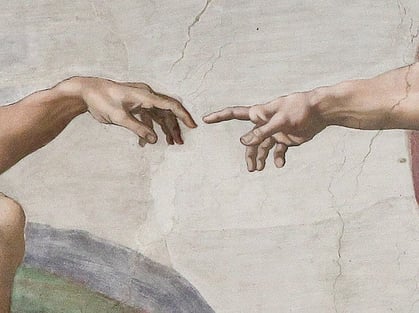The Sistine Chapel, located in Vatican City, is one of the most popular tourist destinations in the world. This relatively small, rectangular space is visited by an estimated five million people per year, many of whom stand in line for hours in the hot sun to score a few crowded minutes beneath its famous frescoes. At any given moment, this solemn chapel where popes are elected is chock-a-block with college students snapping clandestine selfies (photography is not allowed), tour guides silently gesturing (the giving of speeches is also not allowed), and sweating tourists from all over the world gaping and removing ball caps as they crane their necks.
For some, the Sistine Chapel is bigger than they imagined; for others, it’s smaller. For some, the colors are jarringly bright (maybe they have seen photos from before the chapel’s restoration in the 1990s); for others, the colors are muted and gentle.
And everyone has questions. Who are the naked figures between the rectangular scenes? What about that big picture on the wall behind the altar? How did anyone paint up that high, and how did they measure it all out? Why aren’t there more places for people to sit?
A Renaissance Masterpiece: The Sistine Chapel
The Sistine Chapel is certainly a relic from a bygone era—it just smacks “Italian Renaissance,” with its broad-shouldered, heroic nudes, its ingenious, painted-on architecture, and its operatic take on Bible stories. But it’s also curiously contemporary. The iconic image of God creating Adam has inspired a thousand memes: its tantalizing almost-touch between Adam and God speaks eloquently into our age of disconnect and doubt.
The "almost touching" hands detail from the Creation of Adam on the Sistine Chapel Ceiling by Michelangelo / Public domain via Wikimedia Commons
Meanwhile, the barely-clothed figures covering most of the ceiling still command admiration, reminding us of sports heroes and movie stars. Finally, one can’t neglect the orderly, monumental, geometric design of the chapel’s decoration—especially the ceiling, with its sleek parade of rectangles and triangles. There were many painted ceilings in the Renaissance and Baroque periods, but only this one has a forceful geometry that almost, when you squint, seems “modern.”
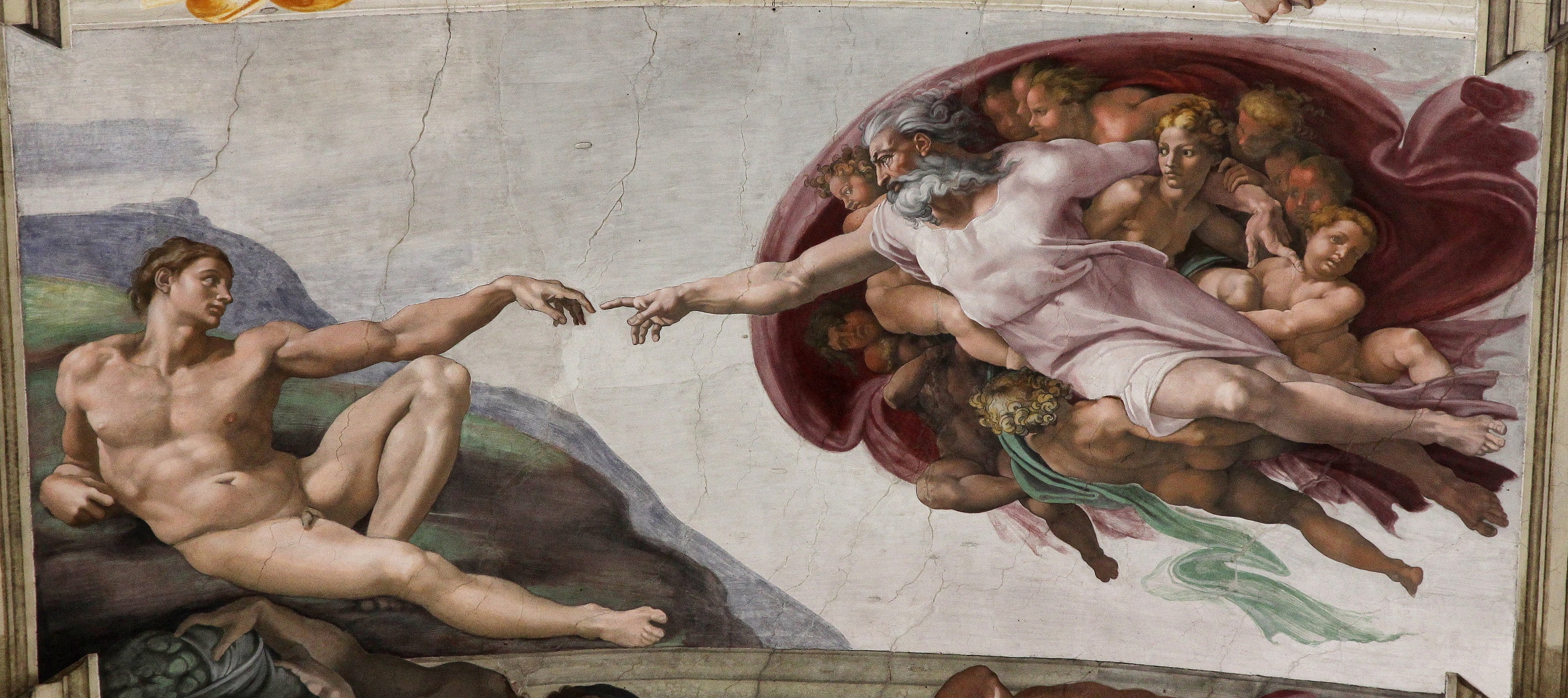 The Creation of Adam on the Sistine Chapel by Michelangelo / CC BY 3.0 via Wikimedia Commons
The Creation of Adam on the Sistine Chapel by Michelangelo / CC BY 3.0 via Wikimedia Commons
The Walls of the Sistine Chapel: Gathering in Sacred History
But I think another part of the chapel’s enduring, strangely universal appeal lies in its creators’ goals to provide just that—something universal. Michelangelo, Pope Julius II, and the Renaissance intellectuals that helped shape the Sistine Chapel were frank in wanting to explore the cross-cultural origins and resonances of the Christian tradition. That goal, in fact, accounts for many of the strange figures lounging in spandrels and niches surrounded by fictional columns. These are not always Bible characters, nor are they Christian saints. Some are thought to be generic representations of all humanity; others are known to be prophets, seers, and teachers from all over the known world.
At the beginning of the 16th century, when Pope Julius II commissioned the great Michelangelo to “crown” the beautiful chapel begun by Pope Sixtus IV, he desired a monument that would somehow gather up all of history and then point into the future. This means that the Sistine Chapel, just like Raphael’s famous School of Athens fresco also in the Vatican, is an attempt to synthesize human wisdom—not just Christian wisdom. Its decorative program is founded on the principle that all truth points to God, that the Church embraces all truth, and that all cultures can contribute to humanity’s understanding of the Good, the Beautiful, and the True.
In a certain sense, this “gathering up” quality is implicit in the Christian Bible, which joins Hebrew Scripture with the new Scripture of the Christians. And in fact, the two-part structure of the Christian Bible is honored on the walls of the Sistine Chapel: a generation before Michelangelo, celebrated artists had rendered scenes from the life of Moses (on the south wall) and the life of Jesus (to the north). This parallelism stressed the harmonies and continuities between the Old and New Testaments and encouraged continued respect for Christianity’s Jewish roots. This harmony was later stressed even further in Michelangelo’s central panels for the Sistine Ceiling, all of which illustrate events from the Old Testament book of Genesis!
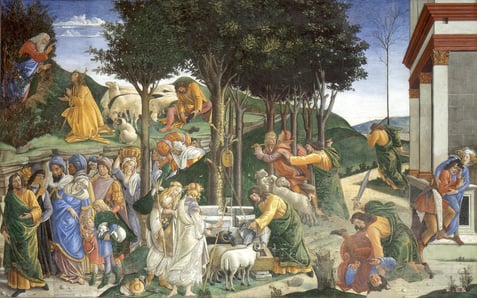 Botticelli, The Trials of Moses, Sistine north wall, ca. 1482 / Public domain via Wikimedia Commons
Botticelli, The Trials of Moses, Sistine north wall, ca. 1482 / Public domain via Wikimedia Commons
Michaelangelo’s Sistine Chapel Ceiling: Gathering in World Cultures
But the Sistine Chapel’s thrust toward synthesis goes beyond its strong Old Testament emphasis. Remarkably, Michelangelo’s ceiling decoration also highlights representatives from other faith traditions. These beautiful figures, some of the most artistically celebrated in the whole composition, are the Sibyls: female representations of authentic spirituality from outside the Judeo-Christian tradition. They include the Persian Sibyl (representing the Middle East), the Erythraean Sibyl (representing a Greek territory), the Delphic Sibyl (inspired by the famous Greek oracle of Delphi), the Cumaean Sibyl (representing an ancient settlement in southern Italy), and the Libyan Sibyl (representing North Africa). Each of these figures is regal and dignified, and each holds a book or scroll. Each also exhibits intensity and prophetic zeal, announcing profound truths granted to them by God in anticipation of God’s greatest revelation, His Son.
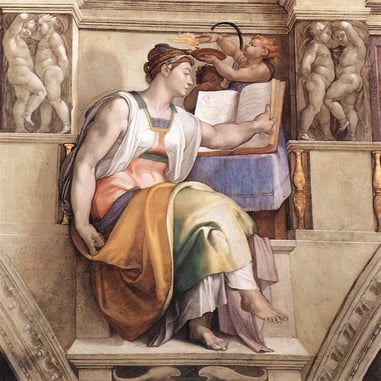 The Erythraean Sibyl by Michelangelo / Public domain via Wikimedia Commons
The Erythraean Sibyl by Michelangelo / Public domain via Wikimedia Commons
Christian audiences have often been surprised by Michelangelo’s inclusion of these multicultural “seers.” But the artist does not want us to be confused about their reliability or truthfulness; he wants us to accept and honor their spiritual insights. Consequently, Michelangelo linked his Sibyls to an array of Old Testament prophets like Isaiah and Jeremiah. For Michelangelo, these sources of spiritual knowledge were complementary. Just as the Jewish prophets foresaw the coming of Christ through the revelations recorded in the Bible, so the world’s “sibyls,” or seers, used God-given spiritual intuition to deduce the Messiah’s advent. In this regard, the Sibyls can be understood as counterparts to the Three Magi of the Gospels—“wise ones” from distant lands whose sincere pursuit of, and openness to, the truth made them witnesses to the birth of the Savior.
The Sistine Chapel: Charged with the Grandeur of God
The Jesuit priest and poet Gerard Manley Hopkins wrote in a famous poem that “the whole world is charged with the grandeur of God.” Christians throughout the Middle Ages and Renaissance believed this in a very fundamental way. The Christian faith, for them, was not some ethereal thing separate from concrete reality and history, but a reliable and accurate way of understanding both reality and history. The whole world was really charged with the grandeur of God, and that meant that non-Christians, and non-Jews, had somehow been bearing witness to this grandeur since the dawn of time. The Incarnation of Christ had simply brought it to a climax.
The harmonic imagination of Christianity, celebrated in the Sistine Chapel and reflected in the works of medieval philosophers like Thomas Aquinas, who synthesized pagan Greek philosophy with Christian theology, is also stamped into the fabric of the city of Rome. As Michelangelo was decorating the Pope’s chapel, he was no doubt aware of the nearby church of Santa Maria in Trastevere, which was built on the spot of a miraculous fountain of oil. This fons olei dated to Roman times before Christ and was thought to be a portent of a world-changing event. The Early Christians naturally folded this local legend into their understanding of the universe and built a magnificent church right on the spot! Meanwhile, in central Rome, on the Capitoline Hill, there stood (and still stands) a church called Santa Maria in Aracoeli. This church is thought to have been built in the location of a pagan sanctuary (erected by Emperor Augustus) where a local sibyl prophesied the coming of a god born of a virgin. Just like miraculous fountains, intuitions of Jesus had been “burbling up” since the ancient ages of the world!
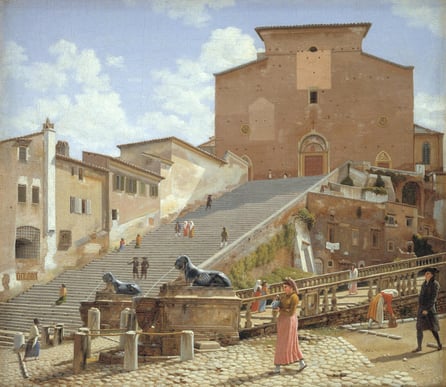 The Marble Steps Leading to the Church of Santa Maria in Aracoeli in Rome by Christoffer Wilhelm Eckersberg / Public domain via Wikimedia Commons
The Marble Steps Leading to the Church of Santa Maria in Aracoeli in Rome by Christoffer Wilhelm Eckersberg / Public domain via Wikimedia Commons
The Sistine Chapel Ceiling Embraces the Human Family
It would be tempting to charge Michelangelo with “cultural appropriation”—that is, with a distorting and self-justifying misreading of ancient sources. What right did Christian scholars and artists have to claim ancient prophecies as their own?
But such claims of “appropriation” sometimes ignore the deep continuity between the ancient pagan world and Renaissance Europe. For Christians like Michelangelo, there was no clear sense that the pagan sibyls (for example) were true “others”—part of a wholly alien paradigm. Instead, they were regarded as ancestors and kin. Their “genetic” cultural connection to Renaissance Italy was undeniable; Michelangelo simply sought to showcase a deep tradition still preserved in the folkways of central Italy. Implicit in this effort (as the dignified images of the sibyls' show) was a profound respect for ancient sources of wisdom and a bedrock belief in a shared, dignified human nature across time and space.
Michelangelo’s grand seers, just like the prophets and patriarchs near them, share the honor of having been created in the “image of God.” Consequently, Michelangelo’s gathering-in of pagan wisdom in the Sistine Chapel is deeply reverent. It comprises an early stage in the Church’s discovery of how all the world’s cultures contribute to our global understanding of a vast and majestic God.
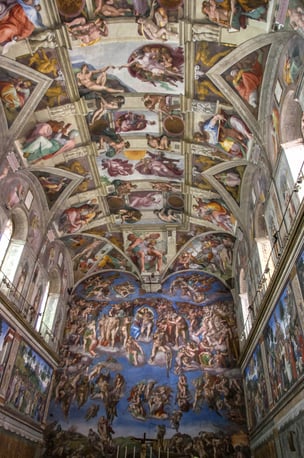 The Sistine Chapel ceiling photographed by Antoine Taveneaux / CC BY-SA 3.0 via Wikimedia Commons
The Sistine Chapel ceiling photographed by Antoine Taveneaux / CC BY-SA 3.0 via Wikimedia Commons
Thus, while Michelangelo’s Sistine Chapel ceiling is so clearly a product of its time, it is also, in spirit, a product of all times. It tries to show how Jesus Christ comes to make all things new. He came to fulfill, illuminate, and “flesh out” ancient prophecies from distant places like Judea, the Mediterranean, the Middle East, and Africa. And in a more intimate way, he came to gather up everything good, true, and beautiful—the world over—into an eternal kingdom that will have no end.


